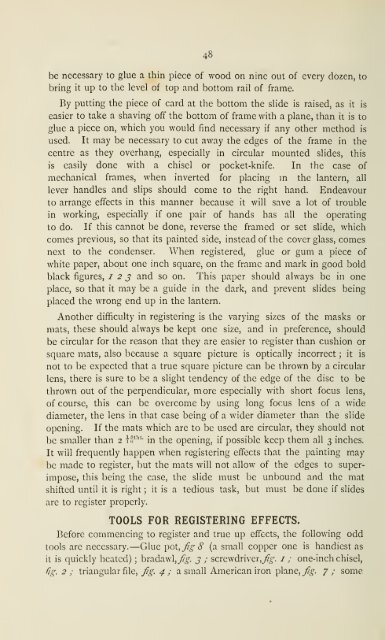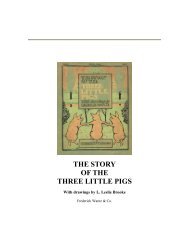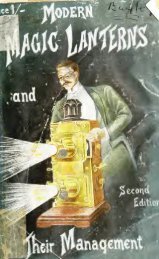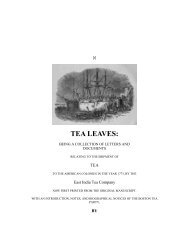The Art of projection and complete magic lantern ... - Yesterday Image
The Art of projection and complete magic lantern ... - Yesterday Image
The Art of projection and complete magic lantern ... - Yesterday Image
- No tags were found...
You also want an ePaper? Increase the reach of your titles
YUMPU automatically turns print PDFs into web optimized ePapers that Google loves.
48be necessary to glue a thin piece <strong>of</strong> wood on nine out <strong>of</strong> every dozen, tobring it up to the level <strong>of</strong> top <strong>and</strong> bottom rail <strong>of</strong> frame.By putting the piece <strong>of</strong> card at the bottom the slide is raised, as it iseasier to take a shaving <strong>of</strong>f the bottom <strong>of</strong> frame with a plane, than it is toglue a piece on, which you would find necessary if any other method isused. It may be necessary to cut away the edges <strong>of</strong> the frame in thecentre as they overhang, especially in circular mounted slides, thisis easily done with a chisel or pocket-knife. In the case <strong>of</strong>mechanical frames, when inverted for placing m the <strong>lantern</strong>, alllever h<strong>and</strong>les <strong>and</strong> slips should come to the right h<strong>and</strong>. Endeavourto arrange effects in this manner because it will save a lot <strong>of</strong> troublein working, especially if one pair <strong>of</strong> h<strong>and</strong>s has all the operatingto do. If this cannot be done, reverse the framed or set slide, whichcomes previous, so that its painted side, instead <strong>of</strong> the cover glass, comesnext to the condenser. When registered, glue or gum a piece <strong>of</strong>white paper, about one inch square, on the frame <strong>and</strong> mark in good boldblack figures, i 2 j <strong>and</strong> so on. This paper should always be in oneplace, so that it may be a guide in the dark, <strong>and</strong> prevent slides beingplaced the wrong end up in the <strong>lantern</strong>.Another difficulty in registering is the varying sizes <strong>of</strong> the masks ormats, these should always be kept one size, <strong>and</strong> in preference, shouldbe circular for the reason that they are easier to register than cushion orsquare mats, also because a square picture is optically incorrect ; it isnot to be expected that a true square picture can be thrown by a circularlens, there is sure to be a slight tendency <strong>of</strong> the edge <strong>of</strong> the disc to bethrown out <strong>of</strong> the perpendicular, more especially with short focus lens,<strong>of</strong> course, this can be overcome by using long focus lens <strong>of</strong> a widediameter, the lens in that case being <strong>of</strong> a wider diameter than the slideopening. If the mats which are to be used are circular, they should notbe smaller than 2 ia""- in the opening, if possible keep them all 3 inches.It will frequently happen when registering effects that the painting maybe made to register, but the mats will not allow <strong>of</strong> the edges to superimpose,this being the case, the slide must be unbound <strong>and</strong> the matshifted until it is right ; it is a tedious task, but must be done if slidesare to register properly.TOOLS FOR REGISTERING EFFECTS.Before commencing to register <strong>and</strong> true up effects, the following oddtools are necessary.—Glue Y>^\.,Jig 8 (a small copper one is h<strong>and</strong>iest asit is quickly heated) ; bradawl,yf^. j ; screwdriver,^/^-, i ; one-inch chisel,fig. 2 ; triangular file, fig. 4 ; vl small American iron plane, fig. 7 / some





